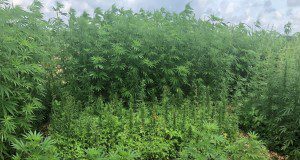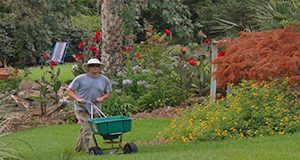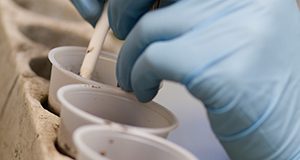This new 6-page publication of the UF/IFAS Department of Soil and Water Sciences is intended to address agronomic and environmental issues related to phosphorus (P) dynamics in Florida agricultural soils and soil test P interpretation and management for agricultural crops. This document aims to provide science-based information to agricultural clientele, including commercial producers, small farmers, Extension agents, crop consultants, landscape professionals, representatives of the fertilizer industry, state and local agencies, students and instructors of high schools and colleges, researchers, and interested Florida citizens. Written by Rao Mylavarapu, Yuncong Li, Maria Silveira, Cheryl Mackowiak, and Mabry McCray.
https://edis.ifas.ufl.edu/ss699
Tag: Rao Mylavarapu
Hemp Fertilization: Current Knowledge, Gaps and Efforts in Florida: A 2020 Report
Hemp is an annual herbaceous plant that may be grown for fiber, seed, or flowers. Starting in April 2020, the Florida Department of Agriculture and Consumer Services began accepting applications for cultivation of hemp in Florida, with the potential for building a $20-$30 billion industry in the state. The statewide UF/IFAS Industrial Hemp Pilot Project is researching aspects of agronomic production for hemp cultivation. While a few other state soil testing laboratories provide soil tests and nutrient recommendations based on research and experience, at this time no Florida-specific data on nutrient requirements and fertilization are available. This new 5-page article, written by Rao Mylavarapu, Zachary Brym, Luis Monserrate, and Michael J. Mulvaney and published by the UF/IFAS Department of Soil and Water Sciences, provides a summary of published and personal communications from different states on hemp fertilization.
https://edis.ifas.ufl.edu/ss689
Urban Fertilizer Ordinances in the Context of Environmental Horticulture and Water Quality Extension Programs: Frequently Asked Questions
Excess nitrogen (N) and phosphorus (P) in water bodies are a leading cause of water quality degradation statewide. More than 50 Florida counties and municipalities now have formal fertilizer ordinances, which in some cases include fertilizer blackouts, or bans on the usage of N and P fertilizers during certain times of the year. This 8-page document provides information on the underlying issues of fertilizer use, with an emphasis on an urban setting, and outlines the current state of the science on urban fertilizers and water quality in Florida. Written by Michael D. Dukes, Lisa Krimsky, Mary Lusk, Laurie Trenholm, Bryan Unruh, Michelle Atkinson, and Rao Mylavarapu, and published by the UF/IFAS Department of Agricultural and Biological Engineering, February 2020.
https://edis.ifas.ufl.edu/ae534
UF/IFAS Standardized Nutrient Recommendations for Vegetable Crop Production in Florida
Soil testing is a scientific tool for effective nutrient management that provides an estimate or an index of the available nutrient-supplying capacity of the soil. This 9-page publication presents the fertilization recommendations for vegetable crops based on soil tests performed by the IFAS Extension Soil Testing Laboratory (ESTL). Written by Rao Mylavarapu, George Hochmuth, and Guodong Liu and published by the UF/IFAS Department of Soil and Water Sciences, December 2017.
http://edis.ifas.ufl.edu/cv002
Agricultural Soils of Florida
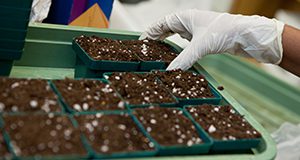
This seven-page fact sheet describes the various soil Orders in Florida, how they were developed, their characteristics, coverage in the state, and uses. This information is important for educating land owners, decision-makers, and educators about soils in Florida, leading to better soil management for agricultural and environmental sustainability. Written by Rao Mylavarapu, Willie Harris, and George Hochmuth and published by the Soil and Water Sciences Department.
http://edis.ifas.ufl.edu/ss655
Guide to Olive Tree Nutrition in Florida
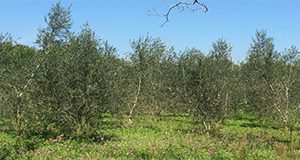 A burgeoning olive industry already exists in the southeastern United States, but research and Extension information regarding olive fertilization recommendations in Florida is limited. While there are data and recommendations for olive from the University of California, the University of Georgia (UGA), and other institutions around the world, there are no data from which we can derive Florida-specific recommendations. This 6-page fact sheet uses many of the existing recommendations for mature, high-density, and traditional grove spacing as guidelines until data specific to Florida production are generated. It discusses leaf tissue sampling procedures, leaf tissue sufficiency ranges, nitrogen fertility, phosphorus and potassium fertility, boron, concerns for olive production in Florida, and other resources for olive production in the state. Written by Michael J. Mulvaney, Rao Mylavarapu, Peter C. Andersen, Mack Thetford, and Jennifer L. Gillett-Kaufman, and published by the UF Agronomy Department, May 2016.
A burgeoning olive industry already exists in the southeastern United States, but research and Extension information regarding olive fertilization recommendations in Florida is limited. While there are data and recommendations for olive from the University of California, the University of Georgia (UGA), and other institutions around the world, there are no data from which we can derive Florida-specific recommendations. This 6-page fact sheet uses many of the existing recommendations for mature, high-density, and traditional grove spacing as guidelines until data specific to Florida production are generated. It discusses leaf tissue sampling procedures, leaf tissue sufficiency ranges, nitrogen fertility, phosphorus and potassium fertility, boron, concerns for olive production in Florida, and other resources for olive production in the state. Written by Michael J. Mulvaney, Rao Mylavarapu, Peter C. Andersen, Mack Thetford, and Jennifer L. Gillett-Kaufman, and published by the UF Agronomy Department, May 2016.
http://edis.ifas.ufl.edu/ag405
Lowering Soil pH to Optimize Nutrient Management and Crop Production
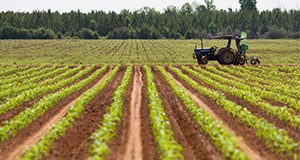
Because temperatures are relatively high and it rains a lot in the region, mineral soils in the southeastern United States tend to be naturally acidic. Managing soils for both pH and nutrients helps maintain soil fertility levels and ensure economic agricultural production. If they are not maintained in the 6.0 to 6.5 pH range, which is best for most crops, most mineral soils in the Southeast will gradually return to their natural acidic state and their fertility levels will drop. In order to keep the soil in the right range, farmers have been encouraged to make routine applications of lime. Calibrated lime requirement tests are part of standard soil tests in this region, but getting the balance right can be tricky. This 4-page fact sheet written by Rao Mylavarapu, George Hochmuth, Cheryl Mackowiak, Alan Wright, and Maria Silevira and published by the Soil and Water Science Department explains the factors that contribute to increased soil pH and describes methods for reducing soil pH that will reduce the chances of either under- or over-liming the soil.
http://edis.ifas.ufl.edu/ss651
The Four Rs of Fertilizer Management
 Supplying needed nutrients for crop production involves attention to four major fertilization factors (the 4Rs): right rate, right source, right placement, and right timing. Attention to these factors will provide adequate nutrition for crop production while minimizing the risk of loss of nutrients to the environment. In this publication each factor is described, as well as how the information can be provided from a soil test report. While not a formal part of the 4Rs, the importance of irrigation to overall nutrient management is stressed in this 4-page fact sheet written by George Hochmuth, Rao Mylavarapu, and Ed Hanlon, and published by the UF Department of Soil and Water Science, October 2014.
Supplying needed nutrients for crop production involves attention to four major fertilization factors (the 4Rs): right rate, right source, right placement, and right timing. Attention to these factors will provide adequate nutrition for crop production while minimizing the risk of loss of nutrients to the environment. In this publication each factor is described, as well as how the information can be provided from a soil test report. While not a formal part of the 4Rs, the importance of irrigation to overall nutrient management is stressed in this 4-page fact sheet written by George Hochmuth, Rao Mylavarapu, and Ed Hanlon, and published by the UF Department of Soil and Water Science, October 2014.
http://edis.ifas.ufl.edu/ss624
Fertilizer Recommendation Philosophies
 Farmers receive varying fertilizer recommendations depending on which lab they consult because labs employ different chemical methods and procedures to analyze the samples and subscribe to different fertilizer recommendation philosophies. This 4-page fact sheet explains the main soil-test philosophies, their basis, and their applications, and explains why the Sufficiency Level of Available Nutrient philosophy (SLAN), also called the Crop Nutrient Requirement (CNR), is most likely to be the best to govern fertilizer recommendations in Florida today. Written by George Hochmuth, Rao Mylavarapu, and Ed Hanlon, and published by the UF Department of Soil and Water Science, October 2014. (Photo by George Hochmuth, UF/IFAS)
Farmers receive varying fertilizer recommendations depending on which lab they consult because labs employ different chemical methods and procedures to analyze the samples and subscribe to different fertilizer recommendation philosophies. This 4-page fact sheet explains the main soil-test philosophies, their basis, and their applications, and explains why the Sufficiency Level of Available Nutrient philosophy (SLAN), also called the Crop Nutrient Requirement (CNR), is most likely to be the best to govern fertilizer recommendations in Florida today. Written by George Hochmuth, Rao Mylavarapu, and Ed Hanlon, and published by the UF Department of Soil and Water Science, October 2014. (Photo by George Hochmuth, UF/IFAS)
http://edis.ifas.ufl.edu/ss623
Soil Testing for Plant-Available Nutrients: What Is It and Why Do We Use It?
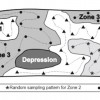 Farmers need soil-testing procedures to assess soils for potential plant-available nutrients. Soil testing is the foremost best management practice (BMP). It helps farmers achieve profitable crops while protecting the environment from excessive fertilization and nutrient losses. This 5-page fact sheet describes the important steps required to test soil for potential plant-available nutrients. Written by George Hochmuth, Rao Mylavarapu, and Ed Hanlon, and published by the UF Department of Soil and Water Science, October 2014.
Farmers need soil-testing procedures to assess soils for potential plant-available nutrients. Soil testing is the foremost best management practice (BMP). It helps farmers achieve profitable crops while protecting the environment from excessive fertilization and nutrient losses. This 5-page fact sheet describes the important steps required to test soil for potential plant-available nutrients. Written by George Hochmuth, Rao Mylavarapu, and Ed Hanlon, and published by the UF Department of Soil and Water Science, October 2014.
http://edis.ifas.ufl.edu/ss621
Developing a Soil Test Extractant: The Correlation and Calibration Processes
 An understanding of soil testing is an important part of preventing excess fertilizer applications that can potentially impact the environment and ensuring commercially viable yields and aesthetic, healthy landscapes. This 4-page fact sheet describes the process UF/IFAS soil scientists used to develop a predictive and/or diagnostic soil test that can be depended on by commercial agricultural and horticultural producers as well as homeowners and can provide accurate nutrient recommendations or diagnose nutrient imbalances for crops or plants. Written by George Hochmuth, Rao Mylavarapu, and Ed Hanlon, and published by the UF Department of Soil and Water Science, October 2014.
An understanding of soil testing is an important part of preventing excess fertilizer applications that can potentially impact the environment and ensuring commercially viable yields and aesthetic, healthy landscapes. This 4-page fact sheet describes the process UF/IFAS soil scientists used to develop a predictive and/or diagnostic soil test that can be depended on by commercial agricultural and horticultural producers as well as homeowners and can provide accurate nutrient recommendations or diagnose nutrient imbalances for crops or plants. Written by George Hochmuth, Rao Mylavarapu, and Ed Hanlon, and published by the UF Department of Soil and Water Science, October 2014.
http://edis.ifas.ufl.edu/ss622
Extraction of Soil Nutrients Using Mehlich-3 Reagent for Acid-Mineral Soils of Florida
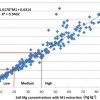 Soil testing is a multistep process starting with the collection of a sample that adequately represents the area or field to be tested. Due to wide-ranging soil conditions across Florida and the United States, multiple soil test methods exist. During the 1970s, Florida along with several other southeastern US states adopted Mehlich-1 (M1) as the official extractant for acidic soils. The UF/IFAS Plant Nutrient Oversight Committee approved the change from M1 to M3 in 2010. Based on observations of the interpretations, the technical committee revised the M3 interpretation in March 2014. The new interpretations have been correlated with the M1 interpretations, as closely and realistically as possible, so the actual nutrient recommendations are not changed. This 7-page fact sheet was written by Rao Mylavarapu, Tom Obreza, Kelly Morgan, George Hochmuth, Vimala Nair, and Alan Wright, and published by the UF Department of Soil and Water Science, May 2014.
Soil testing is a multistep process starting with the collection of a sample that adequately represents the area or field to be tested. Due to wide-ranging soil conditions across Florida and the United States, multiple soil test methods exist. During the 1970s, Florida along with several other southeastern US states adopted Mehlich-1 (M1) as the official extractant for acidic soils. The UF/IFAS Plant Nutrient Oversight Committee approved the change from M1 to M3 in 2010. Based on observations of the interpretations, the technical committee revised the M3 interpretation in March 2014. The new interpretations have been correlated with the M1 interpretations, as closely and realistically as possible, so the actual nutrient recommendations are not changed. This 7-page fact sheet was written by Rao Mylavarapu, Tom Obreza, Kelly Morgan, George Hochmuth, Vimala Nair, and Alan Wright, and published by the UF Department of Soil and Water Science, May 2014.
http://edis.ifas.ufl.edu/ss620
Soil pH Management for Optimum Commercial Fruit Production in Florida
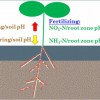 Soil pH is one of the most important soil chemical properties and affects nutrient bioavailability and microbial activity. The purpose of this article is to provide an overview for faculty, crop consultants, crop advisors, fruit growers, and students who are interested in fruit production. The crop response to soil pH varies due to crop genetic diversity. Soil pH determines nutrient bioavailability and hence fruit growth, yield, and quality. This 6-page fact sheet was written by Guodong Liu, Rao Mylavarapu, Ed Hanlon, and Wei Chieh Lee, and published by the UF Department of Horticultural Sciences, April 2014.
Soil pH is one of the most important soil chemical properties and affects nutrient bioavailability and microbial activity. The purpose of this article is to provide an overview for faculty, crop consultants, crop advisors, fruit growers, and students who are interested in fruit production. The crop response to soil pH varies due to crop genetic diversity. Soil pH determines nutrient bioavailability and hence fruit growth, yield, and quality. This 6-page fact sheet was written by Guodong Liu, Rao Mylavarapu, Ed Hanlon, and Wei Chieh Lee, and published by the UF Department of Horticultural Sciences, April 2014.
http://edis.ifas.ufl.edu/hs1234
An Introduction to Biochars and Their Uses in Agriculture
 Biochar, also known as black carbon, is a product derived from organic materials rich in carbon and is found in soils in very stable solid forms, often as deposits. In recent years, considerable research has focused on biochar, its nature, and its properties to explore its potential benefits and negative impacts, particularly for applying to agricultural fields as amendments. This publication provides a general description of biochar, as well as technical details, benefits, and disadvantages of biochar for agricultural and environmental uses. This 4-page fact sheet was written by Rao Mylavarapu, Vimala Nair, and Kelly Morgan, and published by the UF Department of Soil and Water Science, August 2013.
Biochar, also known as black carbon, is a product derived from organic materials rich in carbon and is found in soils in very stable solid forms, often as deposits. In recent years, considerable research has focused on biochar, its nature, and its properties to explore its potential benefits and negative impacts, particularly for applying to agricultural fields as amendments. This publication provides a general description of biochar, as well as technical details, benefits, and disadvantages of biochar for agricultural and environmental uses. This 4-page fact sheet was written by Rao Mylavarapu, Vimala Nair, and Kelly Morgan, and published by the UF Department of Soil and Water Science, August 2013.
http://edis.ifas.ufl.edu/ss585
Watersheds of Florida: Understanding a Watershed Approach to Water Management (SL367/SS568)
 Water is of primary importance to all life on earth. Freshwater is a finite resource, and managing freshwater requires an understanding of watersheds and a watershed approach. Both quantity and quality of water are important for balanced beneficial and efficient agricultural, industrial, rural, and urban uses. This 7-page fact sheet provides information on watersheds and introduces the watershed approach and management concept as practiced in the U.S., with a focus on Florida watersheds in particular. This document also provides information on the basins, basin groups, and hydrologic units of Florida used by the Florida Department of Environmental Protection (FDEP) to implement watershed assessment, monitoring, and restoration programs. Written by Rao Mylavarapu, Kelley Hines, Thomas Obreza, and Greg Means, and published by the UF Department of Soil and Water Science, July 2012.
Water is of primary importance to all life on earth. Freshwater is a finite resource, and managing freshwater requires an understanding of watersheds and a watershed approach. Both quantity and quality of water are important for balanced beneficial and efficient agricultural, industrial, rural, and urban uses. This 7-page fact sheet provides information on watersheds and introduces the watershed approach and management concept as practiced in the U.S., with a focus on Florida watersheds in particular. This document also provides information on the basins, basin groups, and hydrologic units of Florida used by the Florida Department of Environmental Protection (FDEP) to implement watershed assessment, monitoring, and restoration programs. Written by Rao Mylavarapu, Kelley Hines, Thomas Obreza, and Greg Means, and published by the UF Department of Soil and Water Science, July 2012.
http://edis.ifas.ufl.edu/ss568
Field Symptoms of Boron Toxicity and Deficiency in Florida Peanuts (SL366/SS567)
 Boron is an essential micronutrient needed by peanut to prevent “hollow heart” and to provide for sufficient plant growth, but it can be a challenge to manage for peanut production on sandy soils. There may be times when peanut growers, extension agents, and consultants find field symptoms when either boron toxicity or boron deficiency is the cause of peanut yield loss and low kernel quality. This 4-page fact sheet reviews the boron management strategy in Florida, presents information on boron sufficiency and toxicity levels from the literature, and provides photographs of field symptoms that can be used by growers and Extension agents. was written by J. W. Breman, W. D. Thomas, H. E. Jowers, and R. S. Mylavarapu, and published by the UF Department of Soil and Water Science, May 2012.
Boron is an essential micronutrient needed by peanut to prevent “hollow heart” and to provide for sufficient plant growth, but it can be a challenge to manage for peanut production on sandy soils. There may be times when peanut growers, extension agents, and consultants find field symptoms when either boron toxicity or boron deficiency is the cause of peanut yield loss and low kernel quality. This 4-page fact sheet reviews the boron management strategy in Florida, presents information on boron sufficiency and toxicity levels from the literature, and provides photographs of field symptoms that can be used by growers and Extension agents. was written by J. W. Breman, W. D. Thomas, H. E. Jowers, and R. S. Mylavarapu, and published by the UF Department of Soil and Water Science, May 2012.
http://edis.ifas.ufl.edu/ss567
SSAGR335/AG345 Sugarcane Nutrient Management Using Leaf Analysis
SSAGR335, a 7-page illustrated fact sheet by J. Mabry McCray and Rao Mylavarapu, provides growers with sufficiency categories of leaf nutrient concentrations and with nutrient management suggestions for each category. Includes references. Published by the UF Department of Agronomy, July 2010.
http://edis.ifas.ufl.edu/ag345
SL293/SS506 Using Composted Poultry Manure (Litter) in Mulched Vegetable Production
SL-293, a 9-page illustrated fact sheet by George Hochmuth, Robert Hochmuth, and Rao Mylavarapu, answers vegetable producers’ questions about what poultry manure and litter are, what plant nutrients they contain, considerations for using them, results of research in Florida, how to use it in a mulched-bed system, and how to collect and submit for testing poultry manure samples. Includes references. Published by the UF Department of Soil and Water Science, October 2009.
http://edis.ifas.ufl.edu/SS506
SL237/SS456 Development of Bahiagrass Fertilization Recommendations: 1990-2008
Revised! SL-237, a 15-page fact sheet by E.A. Hanlon, Rao Mylavarapu, C.L. Mackowiak, and M.L. Silveira, records changes in UF/IFAS’ bahiagrass fertilization and liming recommendations from 1990 through 2008, and summarizes efforts of the various work groups and committees. Includes references. Published by the UF Department of Soil and Water Science, August 2008.
http://edis.ifas.ufl.edu/SS456
SL281/SS494 Soil Sampling and testing for the Home Landscape or Vegetable Garden
SL-281, a 6-page illustrated fact sheet by Amy L. Shober, and Rao S. Mylavarapu, provides information for homeowners about taking a soil sample and submit it for testing and how to understand the soil test report. Published by the UF Department of Soil and Water Science, March 2009.
http://edis.ifas.ufl.edu/SS494

